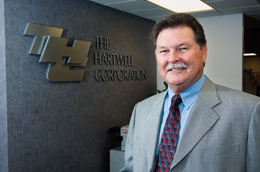|
Sales management: Choices and challenges
Can a sales manager with no insurance experience take agency sales to the next level?
By Elisabeth Boone, CPCU
Sales may be the lifeblood of an independent agency, but many agencies don’t have a formal sales manager position—and others delegate that responsibility to an already overworked producer, one who may be great at acquiring business but lacks the skill and will to manage others.
That’s pretty much what was in the mind of Ralph Hartwell last year when he decided it was time to hire a sales manager for his agency, The Hartwell Corporation (THC) based in Idaho Falls, Idaho. Hartwell founded THC in 1963 and it has grown into one of the largest privately owned independent agencies in Idaho with annual revenues of over $5 million and 60 employees. It also maintains an office in Caldwell, Idaho. In addition to commercial and personal property/casualty insurance, the agency writes surety bonds, life/health and provides financial services.
Three years ago, Ralph Hartwell points out, THC clearly was doing a lot of things right, but he decided that wasn’t enough. “Our agency was profitable, but growth was not meeting my expectations,” he says. Of the agency’s 12 producers, “growth for several was either zero or in the negative.” Like many of its counterparts, THC shuffled the sales manager job among various executives, so no one was consistently responsible for setting sales goals, monitoring progress, or achieving results. “We had a ‘bump’ marketing system,” Hartwell says wryly. “We wrote whatever we bumped into.”
That’s where things stood in 2003 when The Hartwell Corporation joined The Sitkins 100™. Although THC’s management believed strongly in the Sitkins philosophy, Hartwell says, “We struggled with implementing the Sitkins program and culture.” With Sitkins’ encouragement, THC decided to hire a full-time sales manager.
For help in finding qualified candidates for the position, Hartwell turned to Ken Koller, a business acquaintance from outside the insurance business who had a strong background in strategic business planning and marketing management. Koller had spent his entire career in the energy and nuclear power industry, including stints with Westinghouse and the U.S. Department of Energy’s management and operations contractor for the Idaho National Laboratory. He subsequently established his own independent marketing consulting business, Koller & Associates, in Idaho Falls.
The task of finding a sales manager for THC proved challenging, Koller says. “Most of my contacts were in the high-tech field, and I knew plenty of qualified candidates. The problem was the Idaho National Laboratory was expanding, so people with the right background for THC weren’t interested in leaving their current employers. Ralph was eager to get something started, so he asked me if I could come in and help out for a short period of time. I said I’d be happy to come in on a short-term basis and see what I could learn about the Sitkins program as well as the insurance business, and the agency’s operations, so I could give him some recommendations.”
Koller signed a three-month contract during which he was to complete some key tasks, including attending a Sitkins Extreme Networking™ session in the fall of 2005 to learn more about the risk reduction approach used by Sitkins member agencies.
Situation assessment
Koller began his assignment by conducting an assessment to identify THC’s situation and needs. It was a multi-step process: identify the key performance indicators relative to the independent agency business; determine where THC’s numbers fit relative to comparable agencies; compare 2005 performance to 2004 performance for each producer and the agency overall; make initial estimates of what 2006 goals should be; determine to what extent the Sitkins Risk Reduction Approach™ was actually being implemented; and suggest changes to THC’s organizational structure.
Koller conducted one-on-one interviews with each of THC’s 60 employees. “I asked them what they did, why they did it, if they were doing anything they thought was unnecessary, and what ideas they had for making changes and improvements. I got a wealth of information that was very beneficial,” he says. “I summarized my findings and made a presentation to management at the end of 2005.” With the executive team’s blessing, Koller tackled his next task: sizing up the Sitkins approach.
The agency was trying to implement the Sitkins approach “without a full-time sales manager who was committed to making it happen,” Koller says. “They would ask a member of management or a producer to take on that role and at the same time do his own job. The task was passed from person to person without much success. When you give someone that many hats, they’ll wind up doing all their jobs less well than they could. That’s where the effort floundered. Ralph had to make a tough decision: If you invest in a sales manager and pay a base salary that’s coming off the bottom line, is the investment going to pay off?”
Koller continues, “I found out that my own philosophy and the Sitkins philosophy had a lot in common. I figured it was just a matter of taking the best elements of the Sitkins program and my training and experience and melding them into something that could be customized for this agency.”
Moment of truth
A linchpin of the Sitkins approach to sales management is building high-performance teams (HPTs) in which each member has specific responsibilities and is accountable for his or her results. An HPT typically consists of a producer, an account manager, and one or more customer service representatives. “We needed to look at each producer’s team as its own little corporation, so we began a high-performance team profitability assessment,” Koller explains. “Every quarter we look at each team in terms of the total revenue brought in minus commission and sales expense and the salaries and benefits. Based on that analysis, we can determine each team’s bottom-line profitability.”
Inevitably, Koller says, “We found that some teams were very profitable and some were not, and that was an eye-opener. Most of the people here were doing a very good job, but they had no idea how they individually were contributing to the profitability of the overall organization. That’s important, because THC has an ESOP, so the success of the agency drives employees’ retirement planning. For many, this was the first time they made the connection between what they were doing and how it affected their own future success.”
Understandably, THC’s 12 producers were not unreservedly enthusiastic about the idea of being managed by someone with no insurance experience. In fact two decided to leave the agency.
One of the key differences between insurance sales and sales in the industries in which Koller worked was that “every January 1st you started over again with a zero book of business. That is not the case in the insurance business,” Koller says. “In some cases I think that encourages people to be complacent. A producer who has a $500,000 book of business may think that as long as he retains the majority of that business, he’ll make a pretty good living and doesn’t need to put in a lot of extra effort. For an agency looking for more growth, this can be a problem. For producers who were performing at this level, I had to figure out how to motivate them.”
Koller developed and implemented an incentive program for producers and carried through the idea to the customer service staff. He gives credit to the Manuel Lujan Agencies of Albuquerque, New Mexico, another Sitkins member, for the basic foundation of the program. (“Why re-invent the wheel?”) Incentives include 5% additional commissions, paid vacations, and gifts. Awards are presented publicly with certificates and accompanying photos, and peer pressure was used as a motivator through the institution of quarterly sales meetings where all producers were afforded the opportunity to present the status of their book of business and report on their performance toward goals.
Results speak loudly
Koller’s three-month consulting project terminated in the best possible way: He was offered, and accepted, a full-time position as The Hartwell Corporation’s corporate marketing director/sales manager. To kick off 2006, the agency implemented one of the cornerstones of the Sitkins program, trade-downs, resulting in more than 700 accounts being traded down to the customer service staff, getting the producers focused on larger accounts. By midyear 2006, Koller was able to report some impressive results compared with 2005. Total revenue increased 30%, and new business was 103% of the goal for the period. Revenue per employee rose 13%; revenue per producer was up 28%; and revenue per relationship (client) grew by a whopping 272%. Agency gross profits rose 32% and net income recorded a handsome gain of 142%.
On the production side, one producer became the first to reach $100,000 in commission in one month, another producer wrote more new business in one month than he did in all of 2005, topping off his $150,000+ new business year, while five producers achieved more than $25,000 per quarter in new business revenue through June 2006.
These results have everyone at The Hartwell Corporation smiling, especially founder and President Ralph Hartwell. Koller not only has met his expectations, Hartwell says, but has exceeded them in several key ways. Until Koller came on board, “I didn’t foresee the value of adding an experienced strategic business planner to our staff,” he comments. Likewise, “I didn’t anticipate the benefit of bringing in someone with significant corporate, general, and personnel management skills and experience.”
Additional areas where Koller went above and beyond the call of duty, Hartwell says, are: focusing on high-performance team profitability; holding a constructive strategic planning session with specific goals and objectives; publication of a three-year agency master plan; and turning in near-term performance results that exceeded management’s expectations.
As for the man who came in as a consultant with the charge of hiring a sales manager, and ended up being the perfect candidate himself, “This isn’t something I ever thought I’d be doing,” Koller says. “I’m not getting any younger, and I wasn’t looking to make a change in careers. But it’s something I think is fun and challenging, and I plan to enjoy it for some years to come if they’ll have me.” * |
|
Click on image for enlargement |
 |
| |
Ken Koller (far left), Corporate Marketing Director of The Hartwell Corporation (THC) in Idaho Falls, Idaho, had no insurance background when he was hired last year by Ralph M. Hartwell (at right), the CEO of THC. Koller was charged with implementing a new sales management strategy, working initially under a three-month contract. |
| |
 |
| |
Ken Koller heads a meeting of THC’s sales team. |
| |
 |
| |
Koller (left) and the management team. |
| |
 |
| |
“Ralph (Hartwell) had to make a tough decision: If you invest in a sales manager and pay a base salary that’s coming off the bottom line, is the investment going to pay off?”
—Ken Koller |
|


